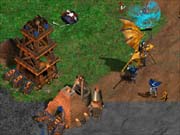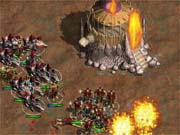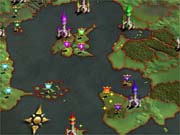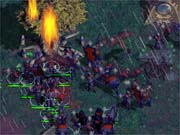When the Warlords series of turn-based strategy games became popular in the early '90s, there was something novel about setting a fairly serious, heavily stats-driven conquest game in a world of swords and sorcery. In the decade since, there's been a profusion of strategy games that have borrowed fantasy trappings to decorate gameworlds of varying originality. The original Warlords games always focused less on story or flashy graphics than on strategic gameplay and risky combat between monstrous units. It's in this way that Warlords Battlecry II can be considered a true real-time heir to the series. It expands on the foundations of the original Warlords Battlecry with a dynamic campaign for conquest, even more playable factions than the original, a new titan unit type, and other gameplay intricacies. But the best part about this sequel is still the RPG-like hero development that so distinguished Warlords Battlecry from other real-time strategy games.

The Warlords Battlecry games' unique feature is that they let you create and control a persistent hero character who gains experience from one battle to the next, specializing in one of many classes and gaining spells and skills in the process. The hero is the essential unit in every battle, not only because of its powerful combat and magical capabilities, but also because of its ability to capture resources, build structures, and give command bonuses to nearby troops. Heroes start out weak and can progress up to level 50, so there's quite a lot of work before heroes come into their own as a major force on the battlefield. If the hero dies, it's still possible to win a scenario or skirmish, though when you create a hero, you choose one of four modes that determine the penalty for dying, ranging from no penalty at all through experience penalties and permanent death.
While developing a hero is slow going at first, Warlords Battlecry II rewards patient character building. The good news is that heroes really are persistent. You can carry a hero over from the single-player campaign into skirmishes and even into open multiplayer games. The lure of gaining levels is a good motivator for pushing through the dynamic campaign, and you have a number of options when building a hero. From the second level, heroes specialize in one of four standard classes: warrior, priest, rogue, or wizard. From there, there are subclasses, each with particular abilities, including assassination skills and eight schools of magic. As you might expect from a game in the Dungeons & Dragons tradition, the race of your hero determines which class options are available. But the overall profusion of choices means that such restrictions actually just help clear out some of the lesser possibilities.
There are plenty of units to back a hero on the battlefield. The original Warlord Battlecry had nine playable factions, and the sequel adds three more to the mix. This isn't as overwhelming as it may seem, partly because some units are on more than one faction's unit list and, though the building art is unique to each race, structures are often analogous. The three types of elves--high elves, wood elves, and dark elves--are all particularly similar, and mostly differ by just one or two units. The barbarians and minotaurs also have some similarities.

Most of the races are conventional fantasy archetypes and have a straightforward, combative style, but the game's developers were more imaginative with the evil races: undead, daemons, dark elves, and dark dwarves. For example, while the dark elves have plenty of standard elven units, their evil magic gives them units like spider queens, who lay eggs in the bodies of fallen foes that hatch into spiders. The undead and daemons have units with strong summoning skills, as the undead's necromancer raises skeletons from the dead and the daemon's summoners makes whip-wielding daemons appear. Higher-level heroes can also learn these and other summoning spells. Warlords Battlecry II has added one new unit type, the titan. Each race has one of these superunits at the top of the tech tree, and as befits their title, they're generally incredibly large and powerful. Still, though, the game's battles often involve so many units by the end that titans aren't impossible to stop.
The story-based campaign of the original Warlords Battlecry has been replaced by a dynamic campaign that details your quest to conquer the world of Etheria. Fortunately, you don't have to conquer all 67 regions in the world to win the campaign--47 will do. There isn't much strategy to the campaign level, as it mostly boils down to selecting a territory to conquer and then playing a skirmish against one or more computer opponents. These skirmishes mostly take place on prebuilt maps, but a few goal-based missions and some pitched battles that have building turned off add some variety. Also, at the start of some turns, there'll be special events, such as mercenaries who offer to join you in the next battle or enemy forces that invade one of your territories.

Success in the campaign does have its advantages, as you can use money earned from holding territories to bring veteran units into the start of a battle. All units can gain experience, which translates into faster attacks and more hit points or mana. And unlike most games with veteran systems, you can carry veteran units over from one battle to the next by adding them to your hero's retinue. But it does take "army points" to bring units into a battle, and more powerful units are balanced by a higher cost. Unlike heroes, veteran units aren't resurrected between battles if they die, so there's some real incentive not to throw these units away needlessly. Overall, the dynamic campaign is a strong reminder of the turn-based heritage of the Warlords series, but the intervening real-time battles between turns are often fairly long unless you corner and kill an opposing hero early on. For this reason, the campaign succeeds more as a framework for skirmishes and hero development than--like in Shogun: Total War--as an operational strategy complement to the game's real-time strategy core.
While there are some alternate victory conditions, most of the game's real-time battles force you to eliminate every enemy unit and building from the map. There are always a few defensive towers to help defend against a rush by an enemy hero and his or her retinue, but there's still plenty of action early in a battle over capturing the four types of resources scattered around maps. Just holding a mine slowly gives you resources, but almost all races have the option of putting builder units into mines to speed up production. Races use different resources for their major upgrades, so it's possible to target enemies' mines to deny them essential resources. The AI for the computer opponents persistently moves toward unguarded resources to capture them, but it doesn't always go after lightly guarded resources very aggressively. The AI tends to send a constant, minor stream of attackers, which makes it easier to defeat. That's a perhaps good thing, since the AI is quite good at micromanaging its forces. But after early resource skirmishes and assassination attempts on enemy heroes, the game's design really shows its preference for large massed attacks. Because of the relatively small and hard-to-click units, large battles can be fairly unmanageable. However, players can give units commands while the game is paused, and the sequel adds new attitude settings to the unit AI to make spellcasters cast spells automatically. Even so, spells cast by non-hero units often seem underpowered when those units are facing a large enemy force.

While it may innovate in terms of gameplay, Warlords Battlecry II won't impress anyone with its in-game graphics. For sure, the 2D art is colorful, crisp, and detailed, and the sequel has added 3D terrain, but the unit animations and designs are quite bland. Idle animations are few and infrequently seen, so the screen can look quite static except during battle. It's a similar story for the game's sound, as the voice acting is passable, but even key units such as heroes have only a few lines. The game's music is actually quite impressive in comparison, ranging from suitably rousing battle music to haunting vocals. Finally, the save game system could have used some polish, as there's only one in-mission save slot, and this is invalidated when your hero levels up, so one of the game's infrequent but inexplicable crashes to the desktop could leave you without whatever hard-fought territory you'd won since your last save. There also aren't any save slots for campaign progress.
Warlords Battlecry II's many playable factions, persistent heroes, and dynamic campaign are innovative elements on top of a solid real-time strategy game. The original Warlords Battlecry was the one of the very first games to effectively use the concept of heroes in a multiplayer-focused real-time strategy game, before Shattered Galaxy or Blizzard's upcoming Warcraft III. If the multiplayer component ends up being popular on the Ubi.com matching service, it should be interesting to create a hero in the service's closed, server-side mode, which allows for competitive rankings. However, while the sequel makes a number of general improvements to the formula established by its predecessor, Warlords Battlecry II doesn't take a big leap forward. The game can be best recommended to players new to the series who are intrigued by the game's hero system.